Want a more visual way to maintain your timeline?
Projects stretch our organizational and creative abilities. They're challenging, they're arduous… and they need an organizational strategy that allows one to create order out of chaos… and at the same time see clearly what it is that we need to be working on at any given moment.
There are endless ways to bring order to a project outline and surface priorities. I've taught a lot on this over the last decade or so. For now, we're going to focus specifically on how our projects relate to the timeline.
Once we have a strategy for representing everything we need to see on our timeline, the organizational structure of any project falls into place rather intuitively.
There are 2 broad categories of projects I'd like to get into in this chapter and the next:
1. Linear projects
2. Time-variable projects »
Linear projects
There are many types of projects, such as this book you're reading, which although might involve varying levels of complexity, they are linear – in the sense that all you need to do to chip away at such projects and eventually complete them, is to regularly set aside time to engage in that project. There may be different facets to the project, but there are not multiple time-sensitive tasks therein. Whenever it's time to work on that project, you simply pick up where you left off.
A linear project is like a round of golf. They both have a linear trajectory. Both involve steady progress. Each swing builds on the last, moving forward through the course… just as a project takes shape a step at a time – with one completed task or paragraph leading to the next and contributing to the whole.
The average score for an amateur golfer on an 18-hole course is around 90 to 100 strokes. For professional golfers, on, say, the PGA tour, it would be an average of 70 strokes. Either way, there are a lot of strokes, broken down into 18 stages. 18 holes, each with their own challenges… nevertheless, there's a progression in time and space. The holes don't get completed on different dates.
Here's what the inside of my WorkFlowy Timeline book outline looks like at the time of writing:
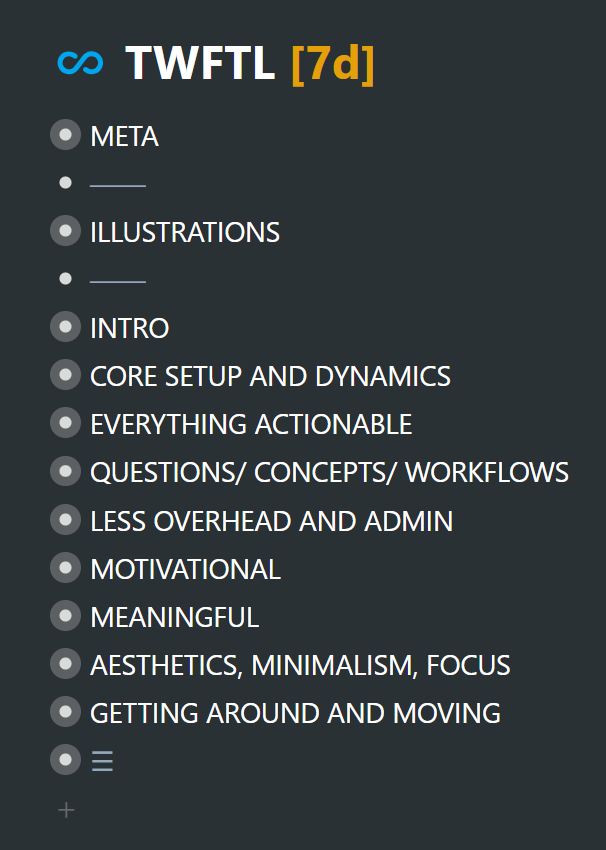
I can work on anything I choose, keeping in mind that there is a deadline. Time is ticking away. 7 days and counting…
What I do with such projects is that they live on my timeline. They live in my daily planner. And when I'm done for the day, this outline gets pushed to the next opportune time on my timeline – through to tomorrow. And then it makes a reappearance in my daily planner the next day.
At the time of writing, it is 2pm on a Saturday in Fortaleza, Brazil. Here's this book project on my timeline:
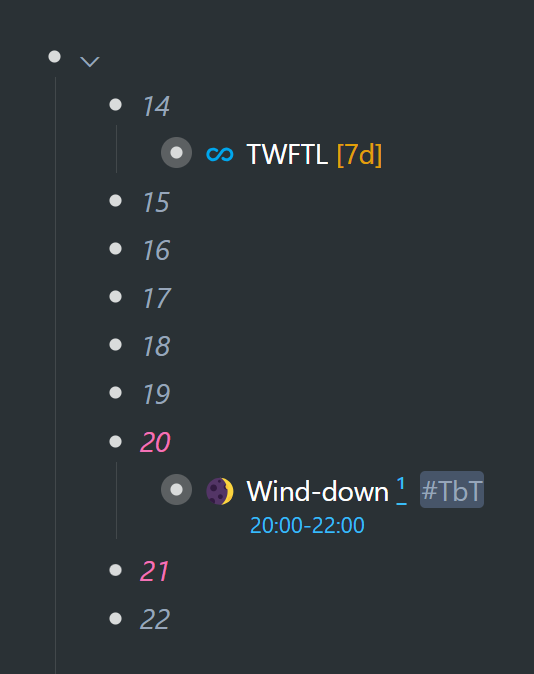
I've cleared out a stretch of time today to focus on this specific project. The project moves along the timeline as the day comes to a close. It's never static. Just like the physical Frank has to move into tomorrow. I've thought about staying put in today for a few more days so that I can cheat the timeline and squeeze in a few more days before my deadline. That's not going to happen. I have to keep up with the times.
Movement
It's quite something to see whole areas and projects moving around in WorkFlowy for the first time. It's a paradigm shift. It's quite something to wrap your mind around – especially if, in your mind, they are seen as immovable, monolithic structures that form the bedrock of your system. It might feel a little strange to see former structures moving along a timeline: a big thing inside a small, temporary thing… a project within a time block – never to stay in the same place for too long. But this is what life is like. This is what time is like. If we're interested in squeezing things (projects, events, experiences, activities) out of life, we've got to squeeze things out of the time we have daily, weekly and monthly.
A little over 20 years ago, I spent 2 years working on the cruise ships. My place of work—my home—was constantly moving from port to port, from island to island. These ships are floating hotels, laid on their sides and given a hull with some large propellers. Large things can move quite nicely from one destination to another on a 3, 4 or 7-day itinerary. Every day of the week, we were at or between predictable ports of call. The whole project moved along according to its itinerary, in space and time. Operating on a timeline is kind of like that. The question is: why not? Has your project got some better place to be, other than at the time and place that you need it to be?
Projects on ice
Here's a project I've been working on for over a year:
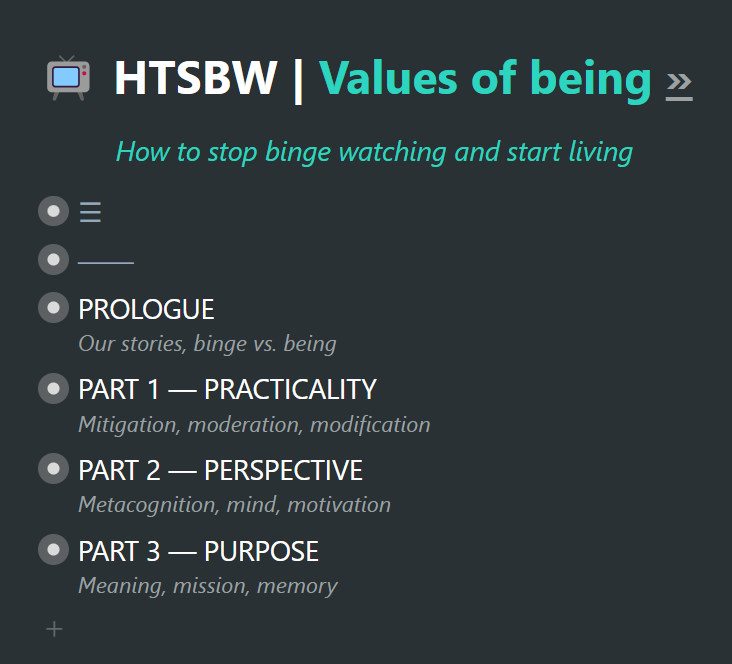
It's my book on "How to Stop Binge Watching and Start Living". It was my main project, but I've shifted my focus for a brief period to take advantage of the momentum I had with the book you're reading right now. The Binge-watching book project does not live on my timeline, but it is situated in line with my timeline. After the release of this book, it will move from its current location back into the timeline proper.
For now, it is temporarily parked under the ⧉ symbol, just below my timeline. I'll explain why I have things set up this way towards the end of the next chapter, but for now, just to show that it's located in an outline immediately below (and in line with) my daily-planner time blocks, my calendar and my journaling outline:
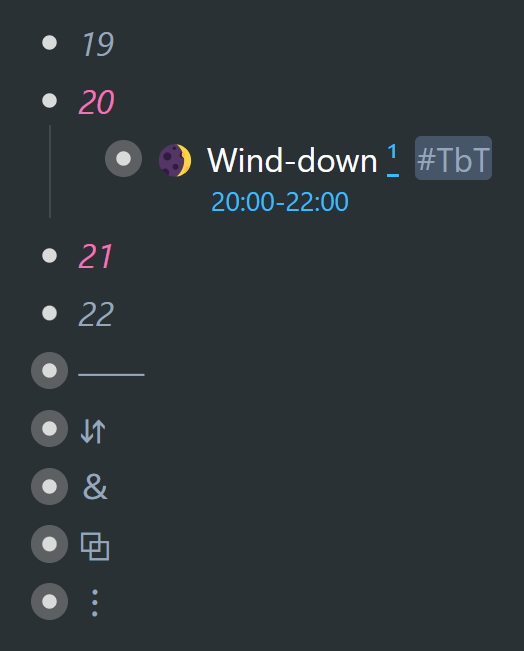
If I expand my ⧉ outline, you'll see a space for projects that don't entirely live on my timeline, but are in fact either represented on my timeline, or else are soon to be brought directly into my timeline.
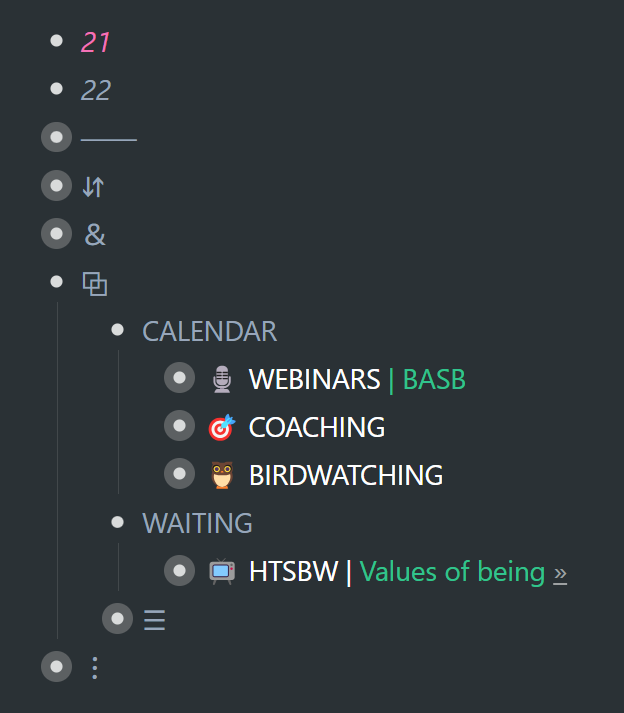
The items under "CALENDAR" all have some sort of representation on my timeline. We'll get to this in the very next chapter… but for now, right there, under "WAITING", is the "HTSBW" book outline, which will shortly be brought back into the fold – back into the timeline. It will then be scheduled the same as the WorkFlowy Timeline book currently is: at the next opportune place on my timeline.
The categories within the above list (CALENDAR and WAITING) show how the items therein are related to the timeline: either they are already represented therein… or they will be grafted in, in due course.
Projects (time variable) →Workflowy is a minimalist note taking app that helps you organize your life. Simple enough to hold your grocery list, powerful enough to hold your entire life.